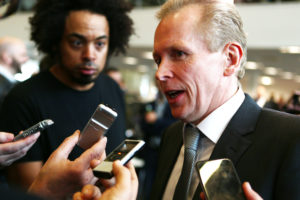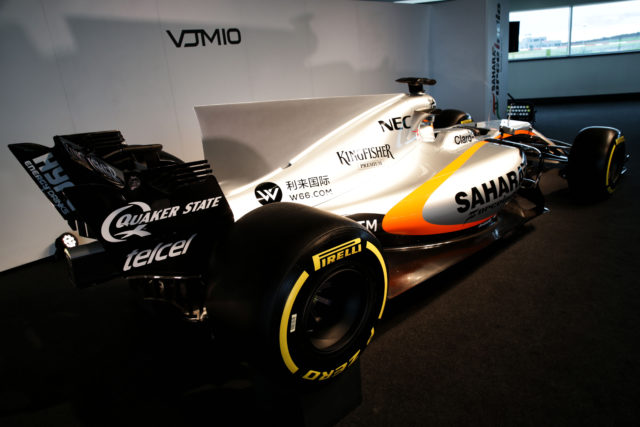Force India’s Technical Director Andrew Green explains what the technical regulation changes mean for the team and the sport in general.
Andrew, the VJM10 is finally here and it looks fantastic. How did it come to life and was it a complete break from the past?
“The VJM10 is the natural product of the big regulation changes for 2017. We had substantial changes to the aerodynamics, to the chassis and to the tyres – combine those three together and you have a marked departure from previous years, with a lot of new ground to cover and a lot more work to do. There was very little to carry over from last year’s very successful VJM09, which meant a lot more work from both a design and a production perspective.”
Did you enjoy the challenge of the new rules? Normally regulations are brought in to slow the cars down, not make them quicker…
“There is a lot more scope for aero development – that’s something that opened up the playing field considerably. It’s definitely gone against the grain of previous seasons but we are enjoying the opportunity it creates. To have all this extra freedom to look for performance is a bit of a culture shock, but it’s a very exciting time for us. It makes it much more fun for everyone involved. Every time we develop a new car, especially under a new set of rules, is a challenge but it’s what we do: we relish the challenge; we look forward to seeing everyone else’s solutions and discovering where we sit in the pecking order. The design of a new car always brings problems that need solving, but finding solutions is what we do every day – it’s what engineering is all about.”

Is this the biggest change in rules you have seen in your F1 career?
“It’s definitely a big overhaul; one that requires a change in mentality. It took a bit of time to adjust at first, but we are there now and I am confident we know where to look and where the performance is coming from in the new car. The development slope is incredibly steep and we are going to see significant updates to the cars at regular intervals, right from the start; it’s going to be big updates and I don’t think development will start to taper off any time soon.”
Pirelli are bringing some new “fat” tyres – how do you expect them to affect the racing?
“The new tyres are not only bigger, but Pirelli is also trying new solutions. We have a lot of learning to do on this front when we get trackside: it’s going to be a challenge, especially at a track like Barcelona in the winter, not exactly the ideal time and place to be tyre testing. The target from Pirelli was to have tyres with lower degradation, but as a team we do not really know what to expect until we get to the track.”
“We have seen the available data, of course, but it’s just theory – we are looking forward to running them for the first time and correlating our tyre models with real data. That’s when the work really starts. The tyres are the same for everyone and it will be crucial to get a handle on them early: we have very capable tyre engineers within the team and we’ll get on top of that as soon as we get the data.”
The VJM09 finished 2016 as one of the strongest cars of the season. What can we expect from its successor?
“That’s the million dollar question! As far as we are concerned, we do not really know whether we have done a good job or not until the moment we get the car on track and compare the data we get on paper with what we get in real life. We know we have done the best job that we can, and we think we are heading in the right direction, but until we get to Melbourne and into qualifying we won’t really know exactly where we stand.”
“As always, there is a little bit of apprehension at this stage in the season – that fear of having missed anything obvious or the hope we have managed to exploit the majority of what we could to the best of our capabilities. I hope it’s the latter! The car has run well in the simulator and we have no reason to doubt the data we get from the wind tunnel, which gave us very good correlation to the track over the last few years. If we can get the performance we see from the tunnel onto the track, we should be in reasonable shape and have a good car to start the season.”
Of course, we have a new face in the cockpit in the shape of Esteban Ocon. What do you think of the team’s latest recruit?
“After three years of stability on the drivers’ side, we have a new kid on the block, and we’re very much looking forward to working with him. He’s a huge talent, we knew that already from the tests he has done with us, and he’s also a really nice guy, which always helps. We’ve had several sessions with him in the simulator already and it’s all gone very well. It was important to have a successful seat fit: he’s not the shortest driver in the world and it’s always good to get a driver of that size comfortable in the car. He’s a really good addition to the team.”
With just days to the first test and a month to the first practice session of the season, are you eager to go back to track or wishing for a few extra days of development?
“We just want to go racing again! When we got towards the end of last year we got a bit tired, as the season was running down and we were pushing really hard to get the fourth place we wanted. It was exhausting, but we did it, we achieved our goal and we could enjoy the Christmas break. Now, everyone is just champing at the bit, wanting to go racing again, which is great to see. We are a real racing team, full of pure racers – you can see that, we just want to get on. The new season is an opportunity for us – an opportunity to do something unexpected. We are optimistic about our chances and we are well aware that, on a season like this, you have to make hay early and take the opportunities that arise. Bring it on.”

































